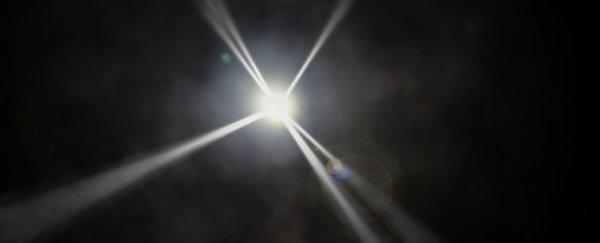Our eyes perceive an object in front of us as being a certain colour depending on what wavelengths of light the object absorbs and reflects. For example, a banana looks yellow to us because it reflects yellow light while absorbing all the other wavelengths at the same time. But what if it was possible to trick our eyes into thinking an object is a different colour, or even invisible?
This is what scientists from the Université Paris-Sud in France have done by interfering in the interaction between light and objects.
And it's not as easy as it sounds. When light hits the surface of single atoms or molecules it causes light particles - known as photons - to be reflected away at odd angles. This is a pretty straightforward process, but things become more complicated when light hits two or more interacting atoms or molecules called emitters - which is the case when hitting larger objects.
As light bounces off one emitter, it changes its electromagnetic field, and that then influences the emitters nearby, which means the photons are scattered in a complex, random pattern. Things get even more complicated because each emitter has an uneven distribution of electrons, causing it to have a positive and negative side, known as a dipole. This makes the emitters like quantum-scale magnets - they repel other emitters that have the opposite side facing towards them.
This is known as dipole-dipole interaction, and although it results in some pretty hectic light scattering, it's also something that scientists can control in order to manipulate how light reflects off an object.
The French researchers have now worked out a way that they can control these dipole interactions so that, in theory, the object won't bounce back any wavelengths of lights into our eyes and appears transparent. They're calling this dipole-induced electromagnetic transparency (DIET).
So far this has only been done in an object made up of just two atoms, but the research paves the way for creating larger molecules that can appear transparent or even different colours to what they really are.
The team believe that DIET could also be used to generate slow light or even to stop the trajectory of light waves, simply by changing the way light interacts with the medium through which it's travelling.
Slow light, occurs when when light is slowed to a fraction of its normal speed. Many of the uses for slow light are largely experimental, but the team reports that it could be useful in optical applications, such as information transmission, switches that use less power, and high-resolution spectrometers.
And stopped light is beyond cool. It forms when light memory - or the image being carried by the light - is stored in crystals.
The ability to change the colour of objects seems like something students would learn at Hogwarts, but researchers say that they must first observe the DIET phenomenon in multilevel atomic or molecular systems to see if it could one day be a reality.
The findings are published in the journal Physical Review Letters.
Source: Phys.org
